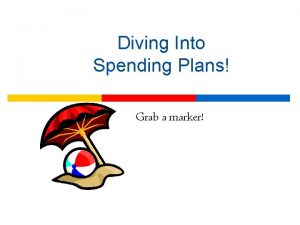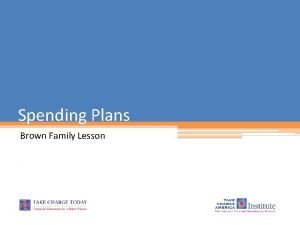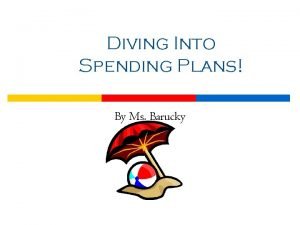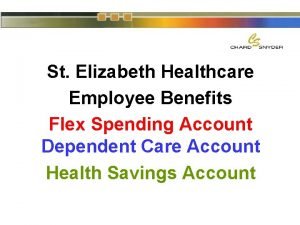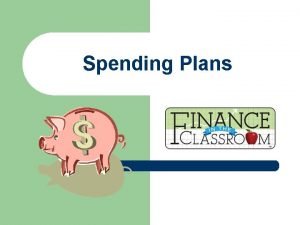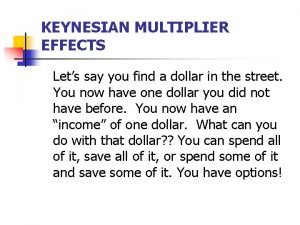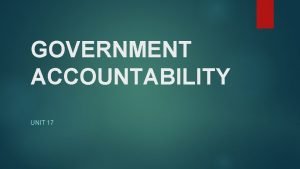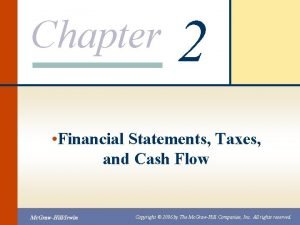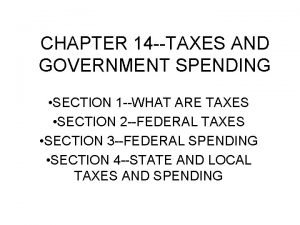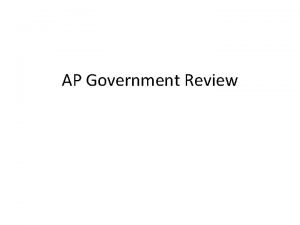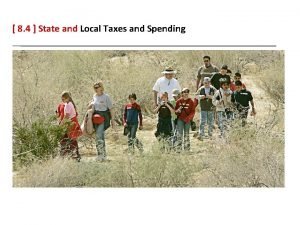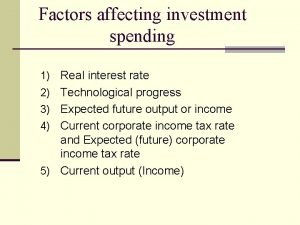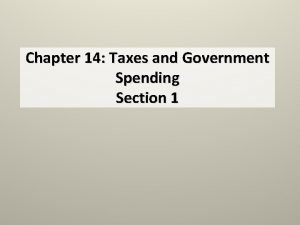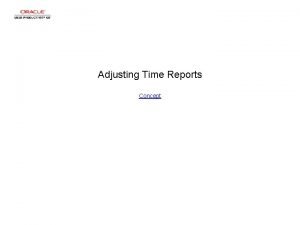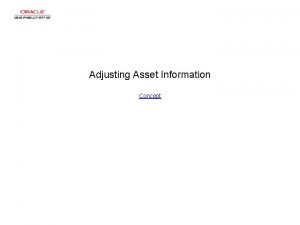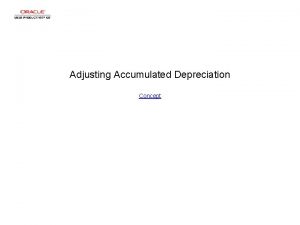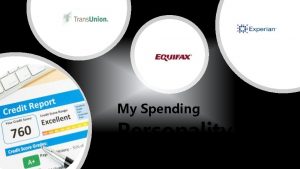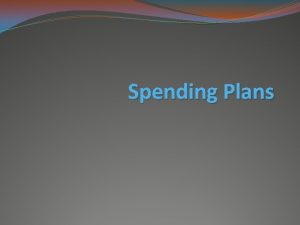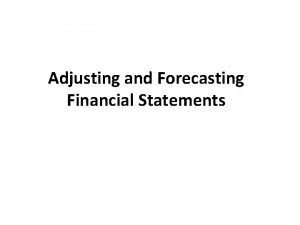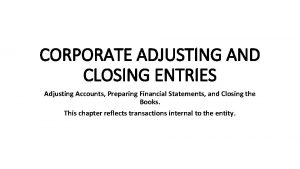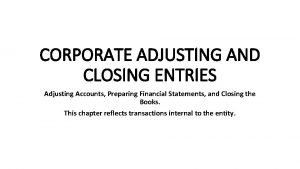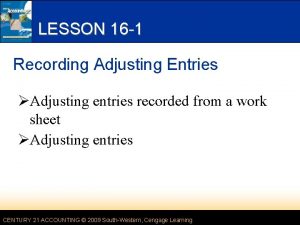Money Management 2 Adjusting Your Spending Plan Hows

































- Slides: 33

Money Management 2: Adjusting Your Spending Plan

How’s It Going? • Have you implemented a strategy that is working for you? • Did you learn anything new as you were tracking expenses? • Did anyone set aside money to save for their goals, for emergencies or for periodic? • Did anyone have a special challenge they overcame? • Who was able to complete the entire homework assignment?

Objectives • Understand how to evaluate your spending plan • Avoid financial pitfalls that hinder our budgeting • Understand how to increase income and plan for variable income • Select the right tracking system for you • Know how to record credit purchases • Prioritize savings • Know how to allocate between debt and savings • Compare spending plan to actual and guideline

How do you feel about maintaining a spending plan?

Your Spending Plan Evaluate and Adjust Plan Build Spending Plan for Goals Organize Data Track Monthly Expenses Forecast Periodic Expenses Participant’s Guide Page: 6

Evaluate Current Spending Plan • Do you have more expenses than Income? • Do you have the same Income and Expenses? • Do you have more Income than Expenses? Participant’s Guide Page: 7

Evaluate and Adjust the Plan • Assess income • Manage expenses – Evaluate needs and wants – Reduce debt – Include savings Needs Wants Savings Debt • Use record keeping systems • Review guideline spending plan Participant’s Guide Page: 8

Live Within Your Means Monthly Expenses Income Participant’s Guide Page: 8

Increasing Income Short-Term • Extra Work – Overtime – Part-time supplemental • Review W-4 tax withholding • Sell Assets – Yard sales/Online sales • Develop Hobbies – Turn a craft or hobby into income Long-Term • Develop career path Participant’s Guide Page: 9

Planning with Variable Income • Salary + Commission – Salary used for needs – Commission used for wants • Irregular Pay – Lowest paycheck allocated to needs – Excess goes to wants • Overtime – Accelerate savings, goals or debt reduction • Savings absolute MUST Participant’s Guide Page: 10

Managing Expenses Present Past Future • Essential • Non-essential • Taxes/Charity • Credit Cards • Installment loans and other debt • Savings • Periodic spending • Investing Participant’s Guide Page: 11

POLL QUESTION! Planning for the future includes (select all that apply): a) Savings b) Rent c) Periodic Expenses d) Funding Goals

ANSWER Planning for the future includes (select all that apply): a) Savings b) Rent c) Periodic Expenses d) Funding Goals

Reducing Expenses Separating Wants and Needs Wants Needs Home phone (landline) Cell phone(s) Cable or satellite television High-speed internet access Gym membership or other memberships Eating out at restaurants A second or third vehicle for kids to drive Vacation trips New clothing for every style and season Purchasing music, books or other hobby items Going to concerts, movies or other events Participant’s Guide Page: 12

Reducing Expenses by Category • Food: – Limit eating out to special occasions – Make a grocery list – Use coupons – Join membership clubs/discount stores – Buy generic or in bulk if you use large quantities – Bag lunch – Drink water when eating out – Your Ideas? Participant’s Guide Page: 14

Reducing Expenses by Category • Clothing • Transportation • Shelter • Utilities • Entertainment Participant’s Guide Page: 14 -15

Set Yourself Up for Success • Revisit Temptations List from Crisis Mode Homework in Passport • Track spending to monitor progress • Work together with family members • Be realistic - Consider quality of life - Allow yourself limited guilty pleasure Participant’s Guide Page: 16

Right Tracking System For You • Envelope Method • Calendar Method • Register Method • Receipts Method • Spending Plan Spreadsheet • Personal Finance Software Participant’s Guide Page: 17

Dealing with Debt • Debt increases current spending • Debt delays savings goals • Make a plan to reduce debt – Evaluate debt – Prioritize debt – Create repayment plan – Celebrate success Participant’s Guide Page: 18

Credit Purchases Example • • • Cindy earns $2, 500 per month Her expenses are $2, 500 per month In December, purchases holiday gifts totaling $600. 00 Cindy puts $600. 00 on her credit card In December, Cindy has $3, 100 in income/expenses INCOME EXPENSES $2, 500 earned income $2500 regular monthly $ 600 credit income $ 600 add’l expense (Gifts) $3, 100 total income $3, 100 total expenses Participant’s Guide Page: 19

Credit Card Income Earned Income $2, 500 Monthly Expenses $2, 500 Credit Card Income $600 Additional Expense - Gift: $600 Total Income – earned and credit $3, 100 Total Expense – monthly & periodic $3, 100 Participant’s Guide Page: 19

Spending by Category Earned Income Credit Income Net Income Regular Expenses (Categorized) Planned Actual INCOME $2, 500. 00 EXPENSES $2, 500. 00 $600. 00 $3, 100. 00 $2, 500. 00 Add'l Expense (Gift) Total Expenses $600. 00 $2, 500. 00 $3, 100. 00 Participant’s Guide Page: 19 -20

Recording Credit Purchases • Record credit card amount as credit income in that month • Record the monthly purchases as an expense • Next month – no new income shows • Expense = credit card payment (Debt) Participant’s Guide Page: 19 -20

Importance of Savings • Reserve for Periodic Expenses • Savings for Emergency • Savings for Goals • Savings for Retirement - Investing Participant’s Guide Page: 21

Debt Reduction & Saving • Pay at least minimum payment on debt • Emergency savings • Periodic reserve • Participate in retirement plan for employer match Participant’s Guide Page: 22

POLL QUESTION! Which categories of savings are important? Select all that apply a) Saving for emergencies b) Saving for goals c) Saving for periodic expenses d) Saving for retirement e) All of the above

ANSWER Which categories of savings are important? Select all that apply a) Saving for emergencies b) Saving for goals c) Saving for periodic expenses d) Saving for retirement e) All of the above

Comparing Actual vs. Planned Category Earned Income Spending Plan (Budgeted) Actual 3, 200 Add’l Income Net Income Savings Housing Groceries Misc. Actual % of Income 3, 200 EXPENSES 100 1, 050 250 40 3, 500 35 1225 352 160 100% 1% 35% 11% 5% Participant’s Guide Page: 23 -24

Guidelines for Spending Percentage of Net Income = Expense/Net Income *** If you have these expenses, other categories would be reduced Participant’s Guide Page: 25

Using a Guideline Category Net Income Savings Housing Groceries Misc Your Guideline Percent 100% 1% 35% 11% 5% 100% 7% 38% 15% 3% Difference 0 -6% -3% -4% 2% Participant’s Guide Page: 26

Monthly Spending Plan • Plan monthly expenses before money comes in • Remember to pay yourself first • Plan for periodic and goals • Compare your actual spending from all sources with your planned spending • Rollover unspent money to use in future months Participant’s Guide Page: 27

Action Plan q Complete Spending Diary q Complete Spending By Category q Compare your Budgeted to your Actual Spending by Category q Adjust your Spending Plan as necessary q Tool: Creating a Cash Flow Budget q Tool: Adjusting Your Cash Flow q Complete Planning Ahead for Shortfalls/Crisis q Reconcile Bank or Credit Union Statement q Continue saving toward your $300 emergency fund and discuss your progress with your coach. q Contact your coach to schedule your monthly coaching appointment.

Need help? Call 757 - 943 -9652 or email info@bankonhr. org.
 Hows your relationship with god
Hows your relationship with god Why is evaluating and adjusting a spending plan important
Why is evaluating and adjusting a spending plan important Money money money team
Money money money team Spending plan shake up
Spending plan shake up The brown family spending plan
The brown family spending plan John and marcia monthly spending plan 1 answer key
John and marcia monthly spending plan 1 answer key Fun budgeting activities for adults
Fun budgeting activities for adults Spending plan shake up
Spending plan shake up Your money your goals toolkit
Your money your goals toolkit Old money names
Old money names Money smart money match
Money smart money match Money on money multiple
Money on money multiple Old money vs new money
Old money vs new money How is daisy described in the great gatsby
How is daisy described in the great gatsby Give us your hungry your tired your poor
Give us your hungry your tired your poor Cash flow identity holds
Cash flow identity holds Nova flex spending
Nova flex spending What is spending
What is spending Moderate spending
Moderate spending Government spending multiplier
Government spending multiplier Government expenditure multiplier formula
Government expenditure multiplier formula Budget multiplier
Budget multiplier Answer
Answer Cash flow to creditors
Cash flow to creditors Net fixed assets
Net fixed assets Chapter 14: taxes and government spending section 1
Chapter 14: taxes and government spending section 1 Deficit spending exists when
Deficit spending exists when Government spending multiplier formula
Government spending multiplier formula Uncontrollable spending definition ap gov
Uncontrollable spending definition ap gov State and local taxes and spending
State and local taxes and spending Factors affecting investment spending
Factors affecting investment spending Convert spending into earning
Convert spending into earning Chapter 14 taxes and government spending
Chapter 14 taxes and government spending Ap gov final review
Ap gov final review



